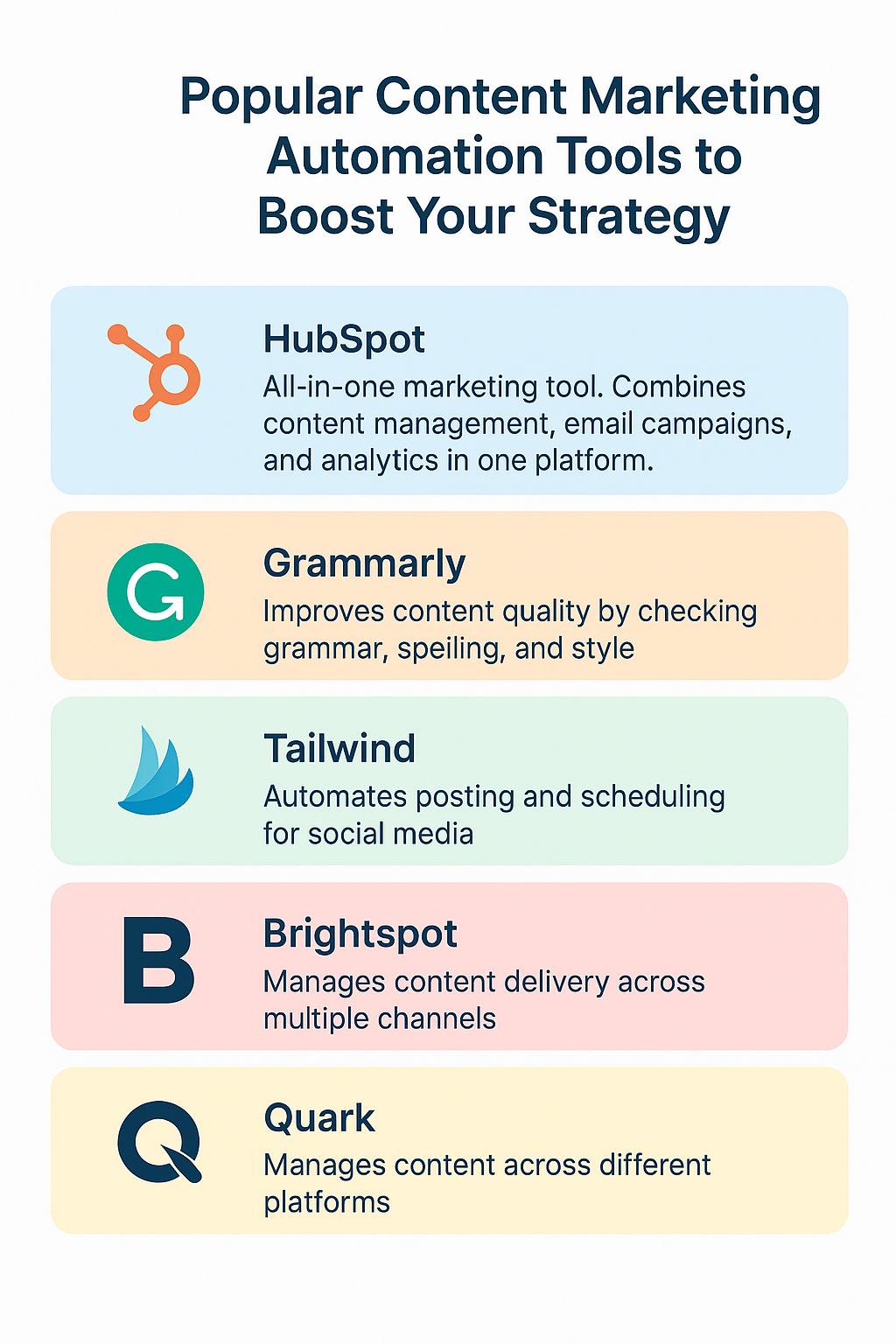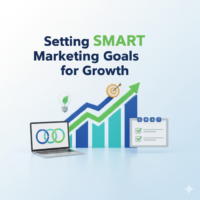Most Effective Content Marketing Automation Strategy
Published: 22 Sep 2025
In today’s fast-paced digital world, staying ahead of the competition requires efficiency and consistency. This is where content marketing automation strategy comes in. By automating repetitive tasks, businesses can save time, boost productivity, and focus on more strategic efforts.

But what exactly is content marketing automation? It’s using tools and software to streamline your content creation, distribution, and analysis processes. Instead of manually handling every step, automation allows you to deliver timely, personalized content to your audience at scale.
This article will guide you through the essential strategies to improve your content marketing automation. You’ll discover actionable tips, top tools, and best practices to enhance your efforts and drive real business growth.
Understanding the Basics of Content Marketing Automation
What is Content Marketing Automation?
Content marketing automation is all about using tools and software to automate the tasks involved in content creation, distribution, and analysis. Instead of manually posting blog updates, sending emails, or scheduling social media posts, automation allows you to set everything up once and let the tools handle the rest.
How It Works
Automation tools help businesses streamline their workflow. These tools can:
- Automatically schedule and post content on social media.
- Send personalized emails to your audience at the right time.
- Track performance and gather insights about your content’s effectiveness.
By automating these tasks, you can spend more time creating valuable content and less on repetitive work.
The Core Benefits of Content Marketing Automation
Content marketing automation offers several key benefits that can make a real difference for your business.
- Time Savings: Automation takes care of repetitive tasks, freeing time to focus on strategy and creativity.
- Increased Productivity: With less time spent on manual tasks, your team can work on higher-value projects.
- Consistent Content Publishing: Automation ensures your content goes out regularly, even if you’re busy with other tasks. This helps keep your audience engaged and your brand visible.
By using automation, businesses can achieve more with less effort, driving better results over time.
The Key Benefits of Content Marketing Automation
Save Time and Improve Productivity
One of the biggest benefits of content marketing automation is saving time. Automating repetitive tasks like scheduling posts or sending follow-up emails frees up your team to focus on more important work. Instead of spending hours on manual tasks, you can focus on strategy and creativity.
Boost Customer Satisfaction
Automation helps you connect with your audience at the right time. By sending personalized emails or messages based on their behavior, you can improve their experience with your brand. For example, suppose a customer abandons a shopping cart. In that case, automation can send them a reminder, helping you engage them and increase the chances of a sale.
Increase Conversions and ROI
Automating lead nurturing makes it easier to follow up with potential customers. Automation tools can send the right messages to the right people at the right time, increasing the chances of converting leads into customers and helping you get more value from your marketing efforts.
Lower Human Error
Humans make mistakes. With content marketing automation, you reduce the chances of campaign errors. Whether it’s a typo in an email or a missed social media post, automation ensures everything runs smoothly, keeping your brand professional and consistent.
Publish Content Consistently
Consistency is key in content marketing. Automation ensures your content is published regularly, even when you’re busy with other tasks. This helps keep your audience engaged and strengthens your brand’s online presence without additional effort.
Reduce Marketing Spend
Automation can also lower your marketing costs. By streamlining processes, you don’t need as many resources to manage your campaigns. This makes it an affordable way to improve your content marketing and achieve better results.
With these benefits, automation saves time and boosts the overall efficiency of your content marketing efforts.
How to Use Content Marketing Automation Effectively
Determine Your Goals
Setting clear goals is important before diving into content marketing automation. What do you want to achieve? Whether generating more leads, increasing customer engagement, or improving brand awareness, knowing your objectives helps you choose the right tools and strategies.
For example, automation can help you send timely follow-up emails to increase lead generation or deliver personalized content based on user behaviour to improve customer engagement.
Select the Right Automation Tool
Choosing the right tool is crucial. There are many options, but you want one that matches your goals and budget. Some popular tools include:
- HubSpot: Great for all-in-one marketing automation, from email campaigns to analytics.
- Mailchimp: Ideal for email marketing automation with easy-to-use templates.
- Buffer: Perfect for automating social media posts across multiple platforms.
Pick a tool that suits your needs. It should help you save time, improve efficiency, and provide useful analytics to track your performance.
Segment Your Audience
Audience segmentation is key to delivering the right content to the right people. Instead of sending the same message to everyone, break your audience into smaller groups based on interests, behaviour, or demographics. For example:
- New Subscribers: Send a welcome email series.
- Active Customers: Offer them exclusive deals.
- Leads in the Funnel: Nurture them with valuable content.
Segmenting your audience ensures that each group gets content that meets their needs and interests.
Create an Automation Workflow
Creating an automated workflow is the next step. This is where you map out the process that automatically triggers actions based on customer behaviour. For example:
- Set up email triggers for when someone subscribes or downloads a resource.
- Schedule social media posts that promote your latest blog post or product.
- Automate blog content delivery to readers based on their interests.
Think of it as setting up a series of steps that run independently. Once it’s set, your content will go out automatically, saving you time.
Optimize and Tweak
Automation isn’t a set-it-and-forget-it process. You’ll need to tweak and improve your workflows regularly. As you collect data, see what’s working and what’s not. For example, if you notice certain emails get more open, adjust other emails to match that style or timing.
Review Metrics
Finally, always track your results. Key performance indicators (KPIs) will help you understand how well your automation works. Some important metrics to monitor include:
- Open Rates: How many people opened your emails?
- Click-Through Rates (CTR): How many clicked-on links are in your emails or social media posts?
- ROI: Are you seeing a return on investment from your automated campaigns?
Reviewing these metrics helps you make data-driven decisions and optimize your automation strategy over time.
Popular Content Marketing Automation Tools to Boost Your Strategy

Regarding content marketing automation, the right tools can make all the difference. Here are some top tools that can help you streamline your strategy and boost your results.
HubSpot
HubSpot is an all-in-one marketing tool. It combines content management, email campaigns, and analytics in one platform. Whether you’re scheduling social media posts or tracking email performance, HubSpot does it all. It’s especially great for businesses looking for a comprehensive automation solution.
Grammarly
Grammarly is more than just a spell checker. It improves the quality of your content by checking grammar, spelling, and style. Using Grammarly ensures your content is polished and professional, which helps maintain a strong brand image.
Tailwind
If you’re focusing on Pinterest or Instagram, Tailwind is a must-have. It automates posting and scheduling, saving you time. You can plan your content, track performance, and even discover trending topics in one place.
Brightspot
Brightspot helps you manage and deliver content across multiple channels. Whether it’s a blog, social media, or email, Brightspot streamlines the process, making it easier to keep your content consistent across platforms.
Quark
Quark is great for managing content across different platforms. It helps businesses create, edit, and distribute content seamlessly. With Quark, you can ensure your content reaches the right audience without the hassle of switching between different tools.
Narrato
Narrato focuses on content creation and collaboration. It’s perfect for teams that need to collaborate on content projects. With Narrato, your team can create, edit, and review real-time content within one platform.
Each tool has unique features that can help boost your content marketing automation strategy. Whether you’re improving content quality, automating social media, or streamlining workflows, there’s a tool to fit your needs.
Best Practices for Content Marketing Automation
Personalize Your Automation
Personalization can make a big difference in your engagement and conversions. With automation, you can still deliver personalized experiences, making your audience feel valued. Here’s how:
- Dynamic Content: Customize emails with content that changes based on a person’s actions. For example, if a customer clicks on a product, send them an email featuring it.
- Audience Segmentation: Group your audience by behaviour, interests, or demographics. This allows you to send relevant content to the right people at the right time.
Personalized messages are more likely to grab attention and convert leads into loyal customers.
Start Small and Scale Gradually
When starting with automation, it’s important to keep things simple at first. Here’s how you can approach it:
- Start with Email Sequences: Set up basic welcome emails or follow-up sequences to engage your audience.
- Automate Social Media: Begin by scheduling a few social media posts to save time and stay consistent.
Once you get comfortable with the basics, you can slowly add more complex workflows, like automating lead nurturing or personalized content delivery. Scaling gradually helps you learn and refine your strategy over time.
Regularly Monitor and Optimize
Automation is not a “set it and forget it” process. Regularly checking how things are going will ensure you get the best results. Here’s why it’s important:
- Review Performance Metrics: Track key metrics like open rates, click-through rates, and conversion rates.
- Tweak Campaigns: If something isn’t working well, adjust your emails, timing, or offers to improve performance.
By continually monitoring and optimizing, you’ll maximize the effectiveness of your automation and keep your audience engaged.
Choose the Right Tools for Your Budget
Many automation tools exist, but not all will suit your business needs. Here’s how to choose:
- Match Tools to Your Business Size: Smaller businesses may not need all the features large enterprises use, so choose tools that fit your current needs.
- Look for Affordable Options: Consider tools that offer good value for money. Some tools have free versions or entry-level plans to get you started without a big investment.
Picking the right tools ensures you don’t overspend while getting the necessary automation benefits.
Take Advantage of Free Trials and Demos
Most content marketing automation tools offer free trials or demos. Don’t skip these opportunities! Here’s why:
- Test Before You Buy: Free trials allow you to see if the tool is easy to use and fits your needs.
- Explore Features: Demos allow you to check out the features before committing. This will enable you to figure out what works best for your business.
Starting with a free trial or demo helps you make a more informed decision without risking a bad investment.
Addressing Potential Drawbacks of Automation
Impersonality in Communication
While automation saves time, it can sometimes make your communication feel impersonal. If you rely too much on automated messages, customers might feel like they’re not interacting with real people. Here’s how to avoid this:
- Personalization: Use dynamic content and segmentation to make messages feel more personal.
- Balance Automation with Human Touch: Reserve some interactions for personal, human communication to keep connections strong.
By finding the right balance, you can still automate processes without losing the human touch.
Predictability
Another risk is predictability. Automating everything without adding variety may make your content repetitive and boring. Here’s what you can do:
- Mix It Up: Change up your content types and messages. Add a mix of videos, infographics, and written posts.
- Test New Strategies: Regularly review what’s working and try new approaches to keep things fresh.
Keeping your content varied will prevent your audience from tuning out.
Spam Risks
When automating emails and messages, it’s easy to slip into spam territory accidentally. If your automated messages aren’t done carefully, they can end up in the spam folder or annoy your audience. To avoid this:
- Focus on Quality: Make sure your emails provide real value to your audience rather than just pushing sales.
- Respect Frequency: Don’t overwhelm your audience with too many emails or messages in a short time.
- Be Transparent: Always allow people to opt out and respect their preferences.
By ensuring your automation feels relevant and respectful, you can avoid the spammy reputation that some automated messages carry.
Addressing these potential drawbacks will help you use content marketing automation effectively while maintaining a strong connection with your audience.
Content Marketing Automation Tools Based on Task Type
Workflow Management Tools
Efficient content creation requires smooth collaboration and a clear workflow. Workflow management tools help you organize tasks, keep track of deadlines, and collaborate with your team. Here are two popular options:
- Trello: A visual tool that helps you manage tasks with boards, lists, and cards. It’s great for tracking progress and assigning tasks.
- Asana: Helps you break down larger projects into smaller tasks. It’s perfect for managing content creation, approvals, and deadlines.
Both tools keep your team on track and make it easier to stay organized, especially when multiple people are involved in content production.
Social Media Automation Tools
Social media is a big part of content marketing, but posting regularly can be time-consuming. Social media automation tools help you schedule posts, track engagement, and manage multiple accounts. Here are some great options:
- Buffer: Simple to use and schedule posts across multiple platforms. You can also track performance and engagement.
- Hootsuite: A powerful tool for managing several social media profiles. It offers scheduling, tracking, and analytics, making managing your content easy across channels.
These tools save you time and ensure your social media is consistent, even when you’re not online.
Email Marketing Automation Tools
Email marketing is one of the most effective ways to engage your audience. Automation tools can help you send personalized emails, follow up with leads, and nurture relationships. Here are two strong contenders:
- Mailchimp: Easy to automate email campaigns, build email sequences, and track open and click rates.
- ActiveCampaign: A more advanced option for automating complex workflows, including lead scoring and email personalization.
Both tools help you create engaging, automated email campaigns that boost conversions.
Data and Analytics Automation Tools
Tracking the success of your content marketing efforts is crucial for improving your strategy. Data and analytics tools help you measure the effectiveness of your campaigns. A few key tools to consider:
- Google Analytics: Tracks website traffic and user behaviour, giving insights into how your audience interacts with your content.
- SEMrush provides an in-depth analysis of your website’s SEO, helping you understand which keywords drive traffic and which content performs best.
Using these tools, you can gather the data needed to tweak your automation efforts and optimize your campaigns for better results.
These tools can help you automate specific aspects of your content marketing strategy, saving time and improving efficiency.
Final Remarks
Content marketing automation is a powerful tool that can save time, improve productivity, and drive better results for your business. You can focus more on strategy and creativity by automating repetitive tasks like email sequences, social media posts, and content delivery. However, balancing automation with personalization is important to maintain a genuine connection with your audience.
Remember, the key to success is starting small, choosing the right tools, and regularly reviewing your performance. Automation can help you scale your efforts and boost your content marketing strategy—but monitoring your metrics, optimizing workflows, and avoiding common pitfalls like over-reliance or predictability is essential.
By applying the best practices and using the right tools for each task, you can create an efficient, effective content marketing automation strategy that supports your business goals. So, embrace automation, but always keep your audience at the heart of your plan.
FAQs
Content marketing automation offers several key benefits:
- Time-saving: Automates repetitive tasks like scheduling and posting, freeing time for more strategic work.
- Increased productivity: You can scale your efforts and handle multiple tasks simultaneously.
- Better customer engagement: Sends personalized content to your audience, increasing the chances of conversions.
- Consistent publishing: Ensures content is regularly delivered to your audience, keeping them engaged.
Content marketing automation uses technology to streamline and automate various tasks in the content marketing process. This includes scheduling posts, sending emails, managing workflows, and tracking performance. It helps save time, increase efficiency, and improve engagement with your audience.
While automation can handle repetitive tasks, striking a balance is important. Over-automation can lead to impersonal communication. Always blend automated messages with genuine human interaction to maintain strong connections with your audience.
When selecting an automation tool, consider the following:
- Your goals: Do you need help with email campaigns, social media, or content management?
- Budget: Choose a tool that fits your budget but offers the features required.
- Ease of use: Ensure the tool is easy to use and integrates well with your existing systems.
Popular tools include HubSpot, Mailchimp, Buffer, and Google Analytics.
Yes, regularly monitoring and adjusting your workflows is crucial. Metrics such as open rates, click-through rates, and conversions give you insights into what’s working and what’s not. Tweaking your automation based on performance will help you optimize your content marketing efforts and improve results over time.
Yes, automation can lower costs by reducing the need for manual labour and making campaigns more efficient. It can also help you target your audience with personalized content, improving ROI and reducing wasted spending on irrelevant messaging.
Some common mistakes include:
- Over-automating and losing the personal touch.
- Failing to review and optimize workflows regularly.
- Sending too many emails or messages can lead to audience fatigue.
- Not selecting the right tools for your business size and needs.
You can get the most out of your automation efforts by avoiding these mistakes.

- Be Respectful
- Stay Relevant
- Stay Positive
- True Feedback
- Encourage Discussion
- Avoid Spamming
- No Fake News
- Don't Copy-Paste
- No Personal Attacks

- Be Respectful
- Stay Relevant
- Stay Positive
- True Feedback
- Encourage Discussion
- Avoid Spamming
- No Fake News
- Don't Copy-Paste
- No Personal Attacks



